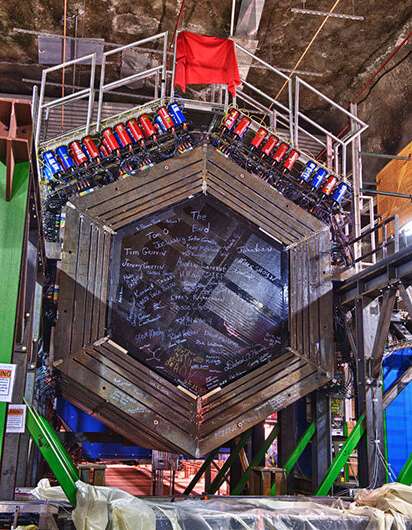Crime scene investigation technique offers a hard look at the traces that particles leave before fleeing the scene

Scientists solve neutrino mysteries by watching them interact with detectors—specifically, with the atomic nuclei in the detector material. Most of the time, a neutrino does not even shake hands with a nucleus. But when it does, the lightweight, neutral particle can transform into a charged particle and knock things out of the nucleus as it escapes—leaving a crime scene behind. Scientists at Fermilab's MINERvA experiment reconstructed the crime scene separating out underlying phenomena to get a clear picture of what happened.
Neutrinos are lightweight particles that rarely interact with matter. Their reluctance to interact makes them difficult to study, but they're also the very particles that could answer longstanding questions about the creation of the cosmos. By studying the traces neutrinos leave behind, scientists gathered more information about the meaning of those traces. The more information they have, the better their neutrino measurements—not just at MINERvA, but at other neutrino experiments as well.
Neutrinos usually sail through matter without bumping into it. But once in a while, it does shake hands with a nucleus, and sometimes the handshake takes a destructive turn: A charged lepton (an electron or muon) is produced, while the constituents of the nucleus are knocked out. A particle detector collects the traces of the charged lepton and the knock-out.
MINERvA scientists study the resultant particles' traces to reconstruct the interaction between the neutrinos and the nuclei. So far, this has not been an easy task: nuclear effects have obscured much of the evidence of the intruding neutrinos, leaving researchers with complex and seemingly irrelevant information. Not all neutrinos misbehave, but, unfortunately, the neutrinos we care about—those with energy comparable to the mass of the constituents of the nuclei and could possibly tell us about the creation of the cosmos—all have this modus operandi.
To reconstruct the resulting crime scene, scientists need a complete understanding of how the nuclear effects work. Both the charged lepton and the knock-out retain partial fingerprints from the original neutrino, and those partial fingerprints lie ambiguously on top of the nuclear effect background. Researchers have found that they can lift the fingerprints via a novel neutrino CSI technique known as final-state correlations. The fine details of the nuclear effects become clear only when other effects are removed.
To get a sense of the final-state correlations technique, let's take a step back and look at the events leading to the crime scene: A neutrino bumps into a nucleus. The interaction produces other particles. Those new particles—charged lepton and knock-out—fly off in opposite directions, leaving traces of themselves in the detector.
If the nucleus were an idle bystander, these escapees would flee the scene back-to-back, perhaps one heading east and the other west. But in reality, the charged lepton's eastward motion does not match the knock-out particle's westward motion. These subtle momentum differences are clues; they reflect everything that happens inside the nucleus, like a shadow of the crime scene cast by the flashlight carried by the neutrino. Thus, neutrinos cast no shadows—only nuclear effects do. The final-state correlations technique matches the nuclear effects with the postinteraction particles' departures from the paths of equal east-west momenta.
Researchers used the new technique. They laid out a detailed reconstruction of the nuclear effects. The underlying phenomena—such as the initial state of the nucleus, additional knock-out mechanism, and final-state interactions between the knock-out and the rest of the nucleus—are now separated.
More information: X.-G. Lu et al. Measurement of Final-State Correlations in Neutrino Muon-Proton Mesonless Production on Hydrocarbon at ⟨Eν⟩=3 GeV, Physical Review Letters (2018). DOI: 10.1103/PhysRevLett.121.022504
Journal information: Physical Review Letters
Provided by US Department of Energy




















